The ten avatars that the Lord and Preserver of the universe Lord Vishnu is believed to have is no new news to any of us.
A third of the Holy Trinity, containing Lord Shiva and Lord Brahma, Lord Vishnu is one of the principal deities in Hinduism, and is believed to have ten primary avatars known as the Dashavatara. These ten avatars represent different manifestations of Lord Vishnu in various forms throughout different time periods.
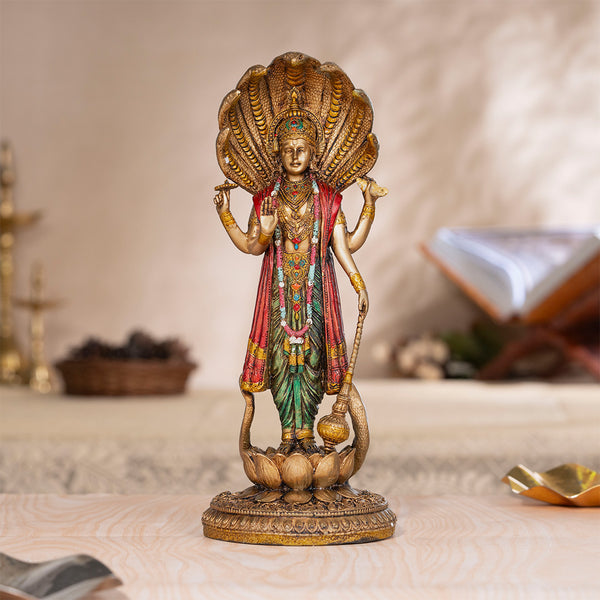
Lord Vishnu Standing Antique Idol (12 Inch)
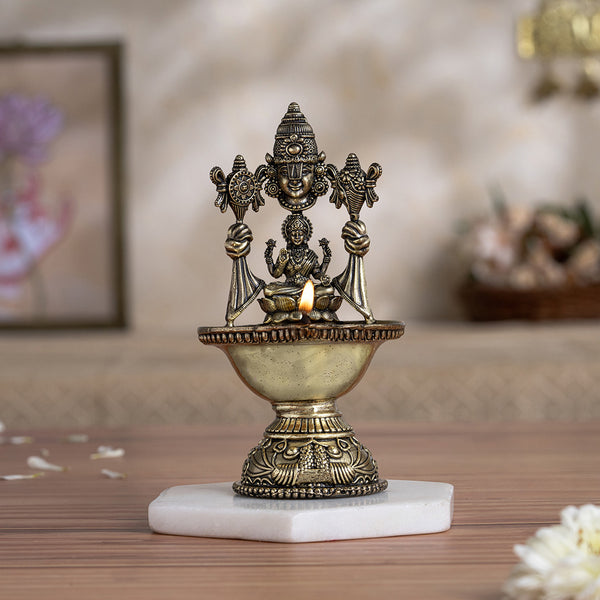
Brass Tirupati Balaji Lakshmi Divine Diya (5.5 Inch)
The ten avatars of Vishnu are believed to have been born for the same purpose. This is to reinstate Dharma, that is justice and righteousness on the Earth and help good triumph over evil, be it demons, asuras, or mortals.
Lord Vishnu's third avatar which is believed to have been born during the Sath Yug resembles the appearance of a boar. Popularly called the Varaha Avatar, this manifestation helped save the planet once again.
Why Did Lord Vishnu Take Varaha Avatar?

According to the legends of Hindu scriptures, the demon Hiranyaksha was responsible for sinking the planet to the ocean floor.
To save it, Lord Vishnu assumed the appearance of a wild boar (Varaha Avatar). It is believed that the fight lasted for a millennium, which is a thousand whole years.
The Varaha Avatar then used his tusks to slay the demon and bring the Earth up out of the depths of the ocean. The Varaha Avatar is typically represented in its animal form or sometimes with the body of a man and the head of a boar, making it a hybrid incarnation. He is often represented as a mighty boar who holds afloat the earth with one of his tusks.
The hybrid half-animal-half-human incarnation of his is shown bearing the weight of Bhuma Devi on his leg.
In the Satya Yuga, Lord Vishnu assumed the form of Varaha to rescue Earth from the clutches of the Asuras and restore Dharma. He took the form of a boar to protect Prithvi, which refers to the earth.
The Varaha Avatar gets its name from the Sanskrit term for "boar" or "wild boar" (Devanagari:,varha). In the Rig-Veda, "Varaha" is translated as "wild boar."
The Third Incarnation Of Lord Vishnu | Varaha Avatar Story
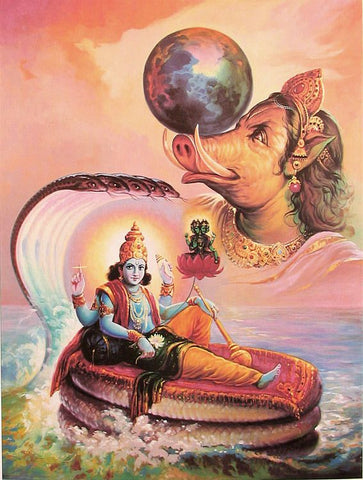
The fascinating tale of Varaha Avatar traces back to the doorkeepers of Lord Vishnu. Vaikuntha Loka is the well-known divine dwelling place of Lord Vishnu. The two formidable gatekeepers, Jaya and Vijaya, stood watch over it. Their deep affection for Lord Vishnu and their undivided loyalty were vowed to protect Lord Vishnu.
The story goes with Jaya and Vijaya holding the power to grant people access to the divine realm of Vaikunta Loka, where they could catch a glimpse of the almighty Lord.
Legend has it that once Lord Vishnu was paid a visit by Lord Brahma's four sons in his heavenly abode of Vaikunta Loka. However, at that moment, Lord Vishnu was taking a well-deserved rest. And thus, Jaya and Vijaya stopped them from meeting Lord Vishnu.
Jaya and Vijaya had managed to incur the wrath of Lord Brahma's sons, leaving them seething with anger. Jaya and Vijaya were cursed to take on human form and be born on Earth. Despite Jaya’s and Vijaya’s pleas for forgiveness, Lord Brahma's sons remained unmoved.
Lord Vishnu then graced them with his presence. He expressed regret for the behavior of his guards. He let the sons of Brahma know that they were acting upon the rules given to them by Lord Vishnu. But, the sons of Lord Brahma showed no change of heart and stood firm in their decision, stating that the curse could not be lifted.
Lord Vishnu delivered this bad turn of events to Jaya and Vijaya stating that the only way to break the curse was for them to meet their demise at his hands. The guards however did not seem deterred by this fate.
And as fate would have it, Jaya and Vijaya were reincarnated as brothers named Hiranyakashipu and Hiranyaksha.
The devotion of Hiranyaksha towards Lord Brahma was truly immense. After years of devoted worship, he received a powerful boon from Lord Brahma himself - the assurance that no being, divine or mortal, could ever bring about his demise.
Hiranyaksha was filled with a sense of invincibility as he believed he had attained immortality. His evilness knew no bounds then as he began inflicting excruciating pain upon unsuspecting victims on our planet.
Hiranyaksha wreaked havoc on the Devas and even went so far as to launch an attack on Indra's celestial palace. The Devas were forced to flee for their safety and seek refuge in the hidden caverns nestled deep within the Earth.
Hiranyaksha then seized the Earth and plunged it into the depths of Patal Loka. This caused the Earth to sink as the Earth's weight was too much for the ocean to bear.
During these happenings, the Earth was under the reign of the powerful Manu and Shatrupa. Manu and Shatrupa approached Lord Brahma seeking solace for their sorrow.
According to legend, Lord Brahma revealed that seeking Lord Vishnu was the only way forward.
Lord Brahma then turned his focus inward and began to meditate upon Lord Vishnu. A tiny piglet was seen emerging from his nostrils.
The once small creature underwent a remarkable transformation, gradually expanding in size until it towered over the landscape like a colossal mountain. This was an avatar of Lord Vishnu. With determination in his voice, he declared that he would plunge into the vast ocean and save Mother Earth.

With a thunderous roar, Lord Vishnu transformed into a mighty boar and launched himself into the sky, his hooves ripping through the clouds.
With unbridled determination, he plunged into the depths of the ocean, on a mission to find Mother Earth. Venturing across the vast ocean, he finally arrived at the other side and made an incredible discovery - deep within its mysterious depths lay Bhoomidevi, the revered Mother Earth herself.
As he journeyed through the vast expanse of the ocean, he came face to face with Varuna, the mighty Lord of the Seas.
With fierce determination, he dared to challenge Varuna Deva to a battle. Varuna's cunning plan involved convincing Hiranyaksha that the only worthy adversary for him was none other than Lord Vishnu himself. Thus, Hiranyaksha was compelled to engage in a fierce battle with the mighty deity.
Suddenly, Narad appeared out of nowhere! Hiranyaksha demanded to know the location of Lord Vishnu. Narad told Hiranyaksha that Lord Vishnu had embarked on a daring mission to save Mother Earth from the depths of the ocean.
With fury in his heart, Hiranyaksha stormed towards the depths of the ocean. In a heroic feat, Lord Varaha plunged his mighty tusk into the depths of the ocean and raised Mother Earth upon it. With a determined stroke, he kicked his way toward the shimmering surface above.
In a fierce encounter, Hiranyaksha charged toward Lord Varaha with his mighty mace. He dared to challenge Lord Vishnu in his Varaha Avatar, claiming that he had the strength to battle with the divine being.
With fierce strength, the demon hurled his mighty mace toward the Lord, ready to strike with all his demonic power. Lord Varaha is said to have taken a step back. The battle continued to rage on.
As the sun began its descent, Lord Brahma issued a dire warning: the demon must be vanquished before nightfall, lest his dark sorcery be unleashed upon the world.
In the battle between Varaha Avatar and Hiranyaksha, the mighty Varaha landed a powerful blow to his opponent's face with a thunderous fist. With a swift motion, he lifted him up and sent him soaring through the air. Hiranyaksha, finally met his demise as he fell over and was killed instantly.
Symbolism And Teachings Of Varaha Avatar
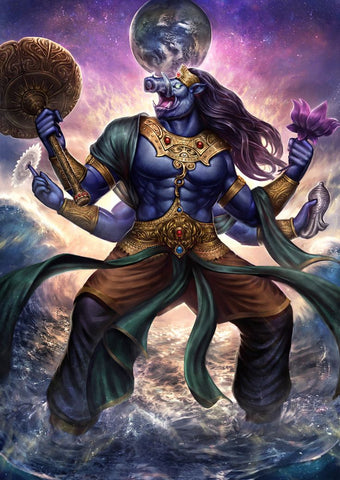
The third avatar of Lord Vishnu, popularly known as Varaha, the boar is widely portrayed as half-man and half-animal. This fierce incarnation is usually seen supporting the weight of the world on his one mighty tusk.
This avatar of Lord Vishnu is believed to be a symbol of sacrifice. The story shows the bringing of peace amidst the chaos. It shows the triumph of good over evil as Hiranyaksha is defeated.
Several temples in the Northeastern part of India worship Lord Varaha during Varaha Jayanti. Varaha Jayanti falls on the third day of the Bhadrapada month of the Hindu calendar.
How Did Varaha Avatar Die?
A fascinating question, it is widely believed, according to Hindu mythology, that the Varaha Avatar of Lord Vishnu did not die. After fulfilling the purpose of the incarnation by saving Earth and defeating the demon Hiranyaksha, the Varaha Avatar returned to Lord Vishnu's divine abode.
The avatar is not considered to be mortal like humans, therefore, does not experience death in the same way. Instead, it merged back into the eternal form of Lord Vishnu, continuing its divine existence beyond the earthly realm.
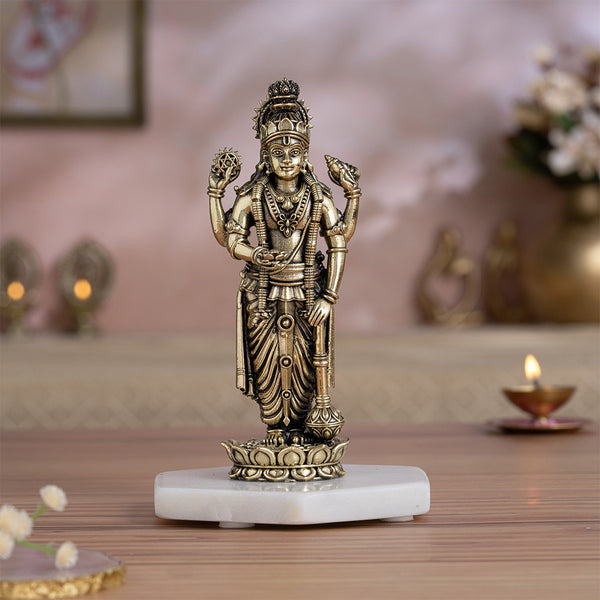
Brass Standing Lord Vishnu Murti (6 Inch)
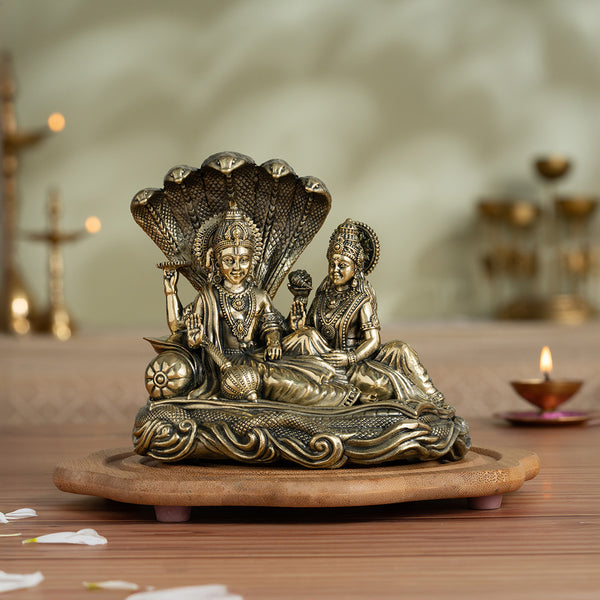
Brass Narayana/Vishnu Lakshmi on Ananta-Sajya (5.5 Inch)
Conclusion
The Varaha avatar of Lord Vishnu holds immense significance in Hindu mythology. This boar incarnation is believed to have come to Earth to rescue the planet from the depths of the cosmic ocean.
Through this avatar, Lord Vishnu demonstrates his unwavering commitment to protecting the universe and upholding righteousness.
The story of Varaha serves as a reminder of the triumph of good over evil and the ultimate victory of divine forces. This avatar continues to inspire devotees and serves as a timeless symbol of divine intervention and salvation.







